This page provides access to a number of time-lapse videos that show interesting events captured by the sky camera. Most of the videos were originally released through the CEDA Document Repository, but have now been transferred to the Zenodo open repository.
All of the are published under a Creative Commons Attribution 4.0 International license. This means that anyone may use them for any purpose, so long as an appropriate credit is given to the original content.
You may either watch the video through the Zonodo website or download it to your computer. Links given in the listings below will open the Zenodo page in a new tab.
The videos cover the following topics:- Cumulus clouds (humilis, mediocris, and congestus)
- Cumulonimbus clouds
- Wave clouds (asperitas, fluctus, lenticularis, undulatus)
- Miscellaneous (22° Halo, Crepuscular Rays)
Cumulus clouds
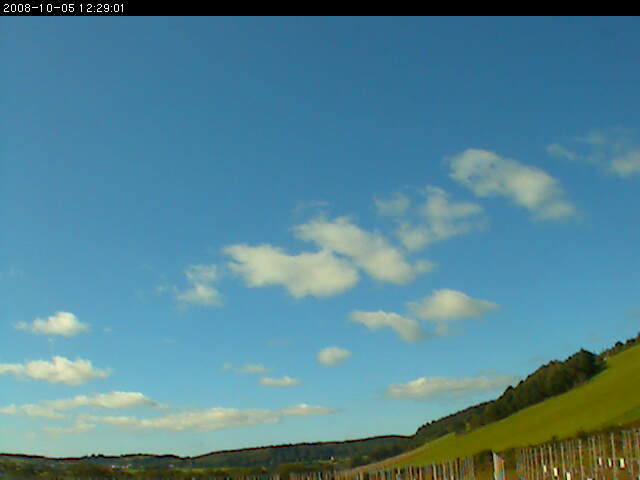
- Description: A time-lapse video showing Cumulus humilis clouds, which are also known as fair weather cumulus.
- Video start time: 2008-10-05 11:00 UTC
- Link to the video in the Zenodo repository (opens in a new tab)
Return to the top of the page.
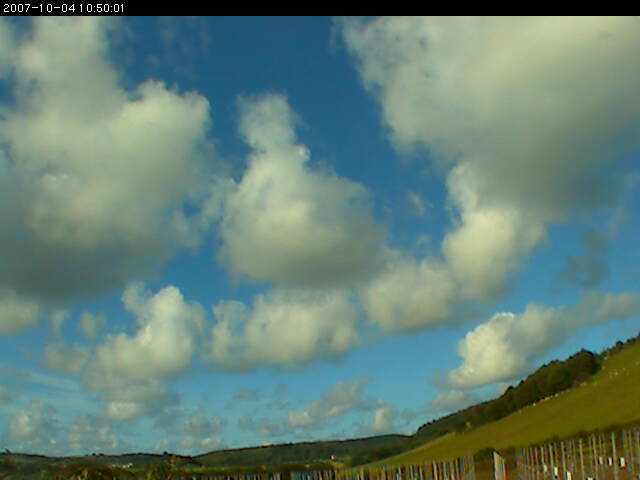
- Description: A time-lapse video showing Cumulus mediocris clouds (with occasional Cirrus clouds and contrails at a higher level). The Cumulus clouds are in a continuous state of change. Many can be seen to form and/or to evaporate within the field of view. The evaporating clouds give rise to ragged Cumulus fractus formations.
- Video start time: 2007-10-04 05:30 UTC
- Link to the video in the Zenodo repository (opens in a new tab)
Return to the top of the page.
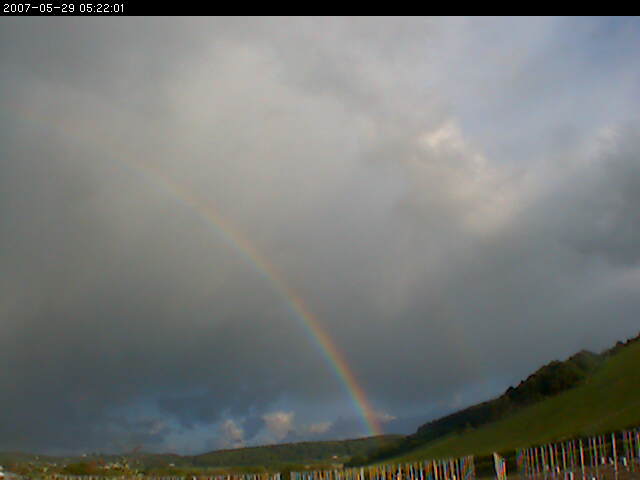
- Description: A time-lapse video showing the development of Cumulus congestus clouds, leading to a Rain Shower and a Rainbow.
- Video start time: 2007-05-29 03:00 UTC
- Link to the video in the Zenodo repository (opens in a new tab)
Return to the top of the page.
Cumulonimbus clouds
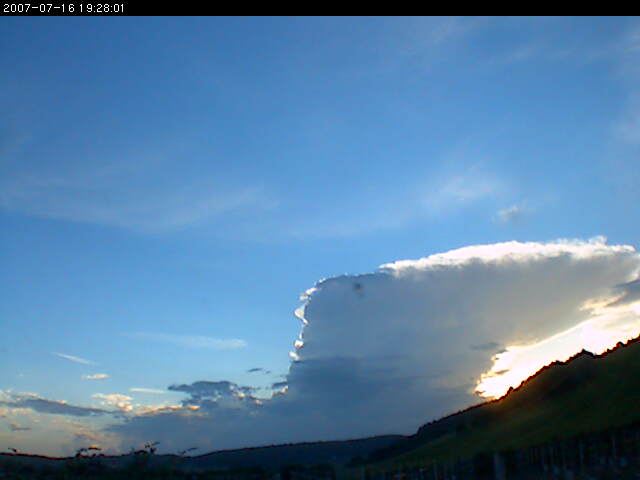
- Description: A rapidly-growing Towering Cumulus [actually a Cumulonimbus] cloud, which develops an Anvil.
- Video start time: 2007-07-16 18:40 UTC
- Link to the video in the Zenodo repository (opens in a new tab)
Return to the top of the page.
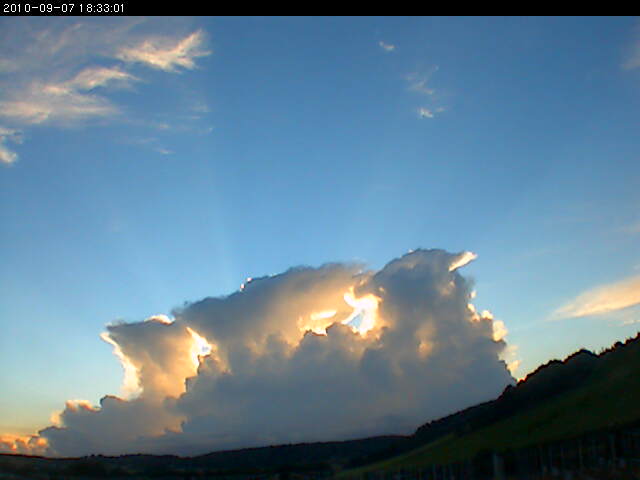
- Description: A time-lapse video showing Cumulonimbus cloud development at sunset. Most of the first Cumulonimbus cloud is obscured by the smaller Cumulus clouds in the foreground. Its anvil is clearly visible. Three further Cumulonimbus clouds cast crepuscular rays from the light of the setting sun. Their anvils merge together.
- Video start time: 2010-09-07 16:50 UTC
- Link to the video in the Zenodo repository (opens in a new tab)
Return to the top of the page.
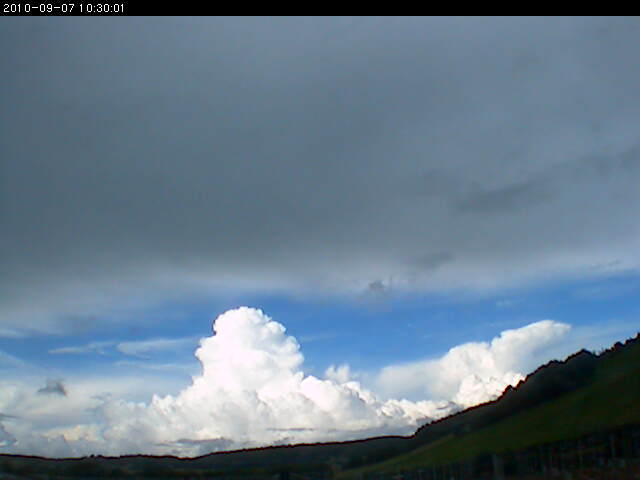
- Description: A time-lapse video showing widespread development of Cumulonimbus clouds, some of which have extensive Anvils. A variety of other cumuloform clouds can be seen. The origin of the widespread cirrus cloud seen during the second half of the sequence is probably outflow from Cumulonimbus anvils.
- Video start time: 2010-09-07 05:30 UTC
- Link to the video in the Zenodo repository (opens in a new tab)
Return to the top of the page.
Wave clouds
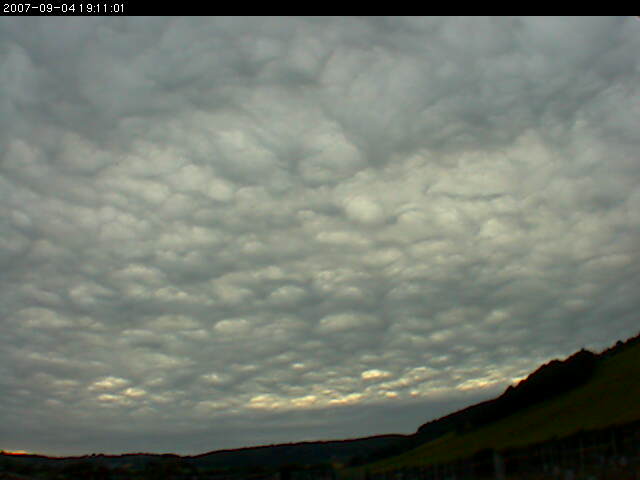
- Description: A time-lapse video showing Stratocumulus clouds that develop wave-like asperitas features. During the early part of the sequence, there appear to be layers of cloud at two distinct levels. These are lit differently by the setting sun. The asperitas features begin to appear approximately half way through the sequence. Altocumulus undulatus clouds can be seen towards the end.
- Video start time: 2007-09-04 17:50 UTC
- Link to the video in the Zenodo repository (opens in a new tab)
Return to the top of the page.
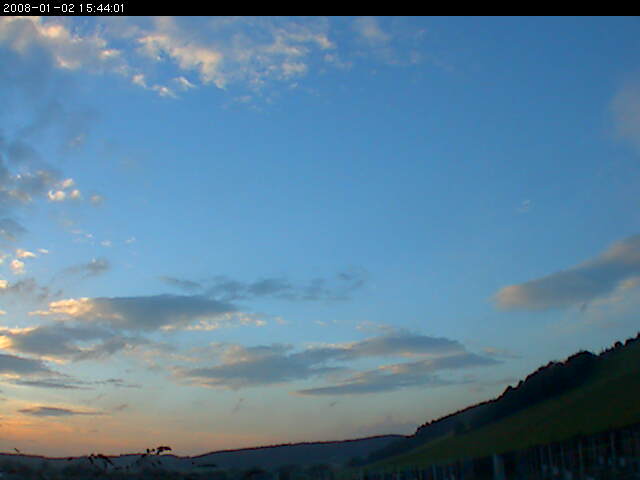
- Description: A time-lapse video showing Altocumulus lenticularis clouds revealing Mountain Wave activity. Notice how the positions of the clouds remain fixed relative to the landscape. This contrasts with the lower-level (Cumulus) clouds, seen at the beginning of the sequence, which move downstream with the wind.
- Video start time: 2008-10-02 15:44 UTC
- Link to the video in the Zenodo repository (opens in a new tab)
Return to the top of the page.
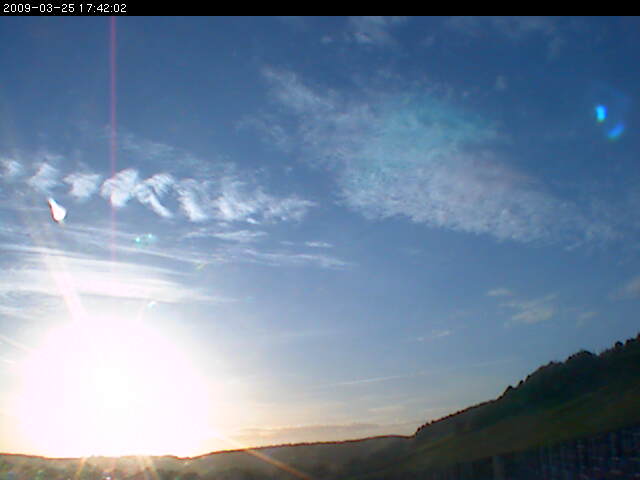
- Description: A time-lapse video showing Altocumulus fluctus and Altocumulus undulatus clouds followed by Altocumulus lenticularis. The short-lived fluctus cloud feature is caused by Kelvin-Helmholtz wave activity, which is generated where the wind speed changes sharply with altitude. The initial telephoto image shows the characteristic breaking-wave pattern. This was taken (at 17:37 UTC) at the same location as the camera used to to generate the video sequence, but shows a narrower field of view. The wave activity is also revealed by the Altocumulus undulatus cloud elements, which form in parallel bands. There is evidence of mountain wave activity throughout the sequence and Altocumulus lenticularis becomes the dominant cloud type towards the end. These clouds remain stationary relative to the landscape rather moving with the wind. Occasional contrails and Cirrus clouds can be seen at a higher level (one of the contrails develops undulatus features). These remain illuminated for longer than the Altocumulus clouds as the sun sets.
- Video start time: 2009-03-25 17:25 UTC
- Link to the video in the Zenodo repository (opens in a new tab)
Return to the top of the page.
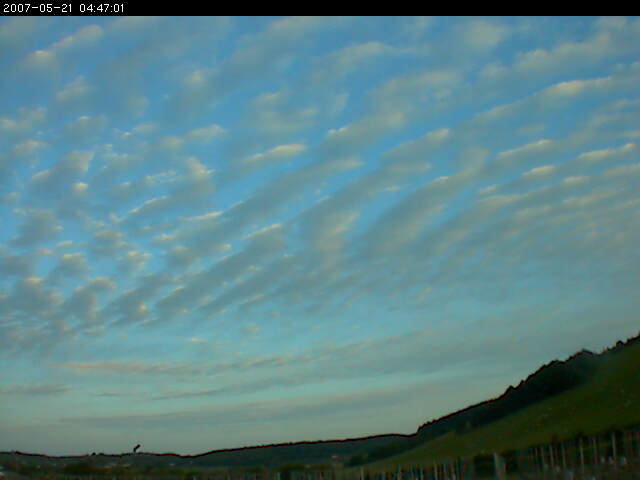
- Description: A time-lapse video showing Altocumulus undulatus clouds. The cloud layer initially appears to be of Stratocumulus type, with relatively poorly-defined undulatus elements. However, the layer soon breaks up to give well-defined Altocumulus undulatus. Cirrus clouds and contrails can be seen at a higher level towards the end of the sequence.
- Video start time: 2007-05-21 03:00 UTC
- Link to the video in the Zenodo repository (opens in a new tab)
Return to the top of the page.
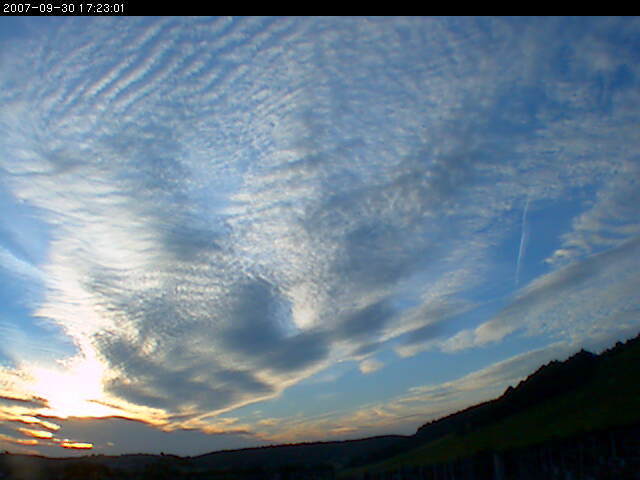
- Description: A time-lapse video showing Altocumulus clouds displaying both undulatus and lenticularis features. A lower cloud layer can be seen moving in a different direction at the beginning of the sequence. Contrails and cirrus clouds can be seen at higher levels.
- Video start time: 2007-09-30 14:30 UTC
- Link to the video in the Zenodo repository (opens in a new tab)
Return to the top of the page.
Miscellaneous
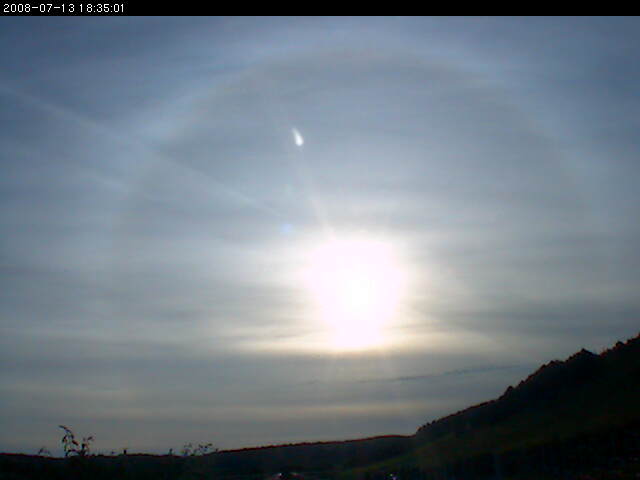
- Description: A time-lapse video showing Cirrostratus clouds giving rise to a 22° Halo around the Sun. A number of aircraft Contrails pass through the field of view and a Sun Dog can be seen briefly towards the end of the sequence.
- Video start time: 2008-07-13 18:00 UTC
- Link to the video in the Zenodo repository (opens in a new tab)
Return to the top of the page.
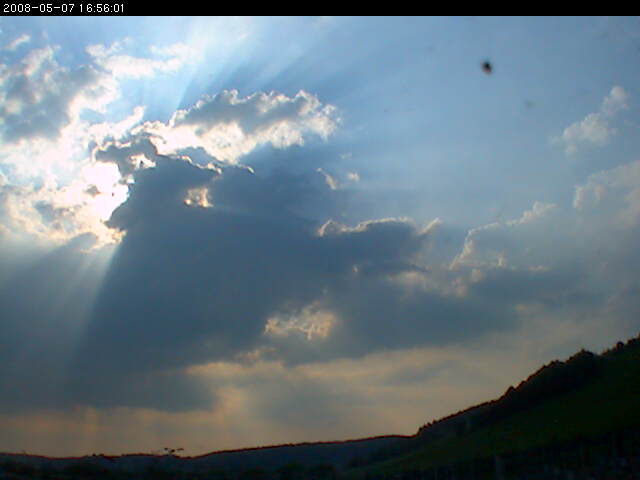
- Description: A time-lapse video showing Crepuscular Rays. These are shafts of light that appear to radiate from the sun. The effect is caused by the sunlight scattering from aerosols, i.e. small particles such as dust and smoke that are suspended in the atmosphere. It is usually seen when broken clouds are present, which leads to alternating shafts of light and shadow. The rays of light from the sun are actually parallel, but they appear to converge because of the effects of perspective. This is the same effect that makes roads appear to become more narrow as they recede into the distance. The word crepuscular implies twilight and so the term crepuscular rays is sometimes reserved for the effect that is seen when the sun is just below the horizon. However, crepuscular rays can potentially be seen at any time of day. They tend to be most dramatic when the sun is low in the sky and when the concentration of aerosols is particularly high. Although the clouds in this video look like Cumulus, the cloud base (detected by a laser ceilometer at the same location as the camera) is above 2 km suggesting that they are Altocumulus castellanus.
- Video start time: 2008-05-07 15:00 UTC
- Link to the video in the Zenodo repository (opens in a new tab)

 THE NERC MST RADAR FACILITY AT ABERYSTWYTH
THE NERC MST RADAR FACILITY AT ABERYSTWYTH